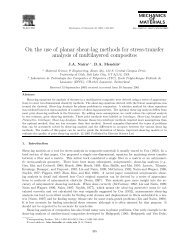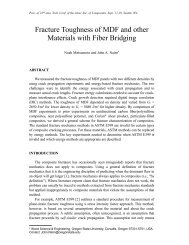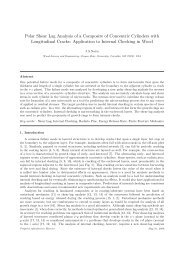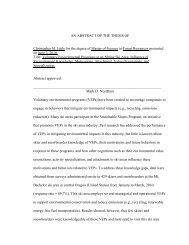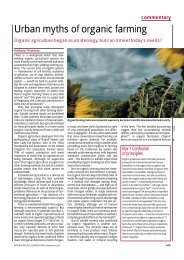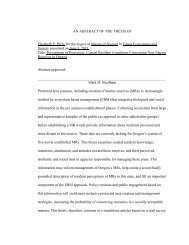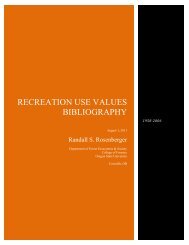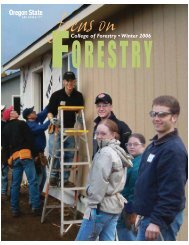College of Forestry - Oregon State University
College of Forestry - Oregon State University
College of Forestry - Oregon State University
Create successful ePaper yourself
Turn your PDF publications into a flip-book with our unique Google optimized e-Paper software.
Features<br />
Tuning into Timber Trends: Fast Forward to the Future<br />
No sensible decision can be made any longer without taking into account not only the world as it is, but the<br />
world as it will be.—Isaac Asimov, in The Encyclopedia <strong>of</strong> Science Fiction<br />
Housing starts in California, the pine<br />
beetle outbreak in interior British Columbia,<br />
harvest and markets for <strong>Oregon</strong><br />
timber—how are these related Where<br />
will the wood come from in 10 years—or<br />
50—to provide lumber, paper, and other forest products<br />
How can thinning to improve forest health be made<br />
economically attractive How can the US forest industry<br />
continue to compete globally Darius Adams, Pr<strong>of</strong>essor<br />
<strong>of</strong> Forest Resources and economist, has spent more than<br />
30 years engrossed in such questions. His answers have<br />
provided vital information to woodland owners, forest<br />
products producers, and government agencies, statewide<br />
and nationally.<br />
Adams and his students use complex models to<br />
establish market and harvest trends and patterns. They<br />
range from small scale (a single <strong>Oregon</strong> county) to large<br />
(national and global) and flow from one scale to the other.<br />
The local models incorporate many diverse factors affecting<br />
timber harvest and manufacture <strong>of</strong> wood products.<br />
The larger models include national and international<br />
wood products markets, including products from other<br />
regions that move to larger markets and therefore affect<br />
<strong>Oregon</strong>. For example, the US currently imports nearly<br />
40% <strong>of</strong> the lumber it consumes yearly, primarily from<br />
Canada. Salvage logging <strong>of</strong> beetle-killed trees in British<br />
Columbia over the next decade is likely to increase<br />
supplies from Canada. At the same time, housing starts<br />
in the US likely will decrease (reducing demand) and<br />
accelerating urbanization will absorb more forested lands<br />
(reducing timber supply). All these factors and more must<br />
be considered in the models. Similar complexities arise in<br />
dealing with other forest products, such as paper.<br />
Economic modeling has recently become important<br />
in forest health initiatives. Adams and his research assistant<br />
Greg Latta recently completed a study <strong>of</strong> costs and<br />
regional impacts <strong>of</strong> restoration thinning on national forests<br />
in eastern <strong>Oregon</strong>. Their model responded to a need<br />
to forecast market response to and economic implications<br />
19<br />
<strong>of</strong> thinning programs proposed<br />
to reduce fire and pests in overstocked<br />
forests. The scenarios<br />
they treated included the extent<br />
<strong>of</strong> public subsidies, the types <strong>of</strong><br />
costs that could be subsidized,<br />
the form <strong>of</strong> subsidy payment,<br />
and effects on log consumers<br />
and producers.<br />
Over the years, Adams has<br />
noticed many changes in his field. Chief among them is<br />
the shift in proportion <strong>of</strong> harvest from public land ownerships<br />
to private. “In the late 1970s, timber supply and<br />
market issues were radically different,” he notes. “More<br />
than half <strong>of</strong> the harvest in <strong>Oregon</strong> was from public lands.<br />
Now, public lands are <strong>of</strong> limited consequence, and the focus<br />
is on private lands.” In addition, industrial owners in<br />
particular have been moving from integrated ownership,<br />
in which they own timberlands and processing facilities,<br />
to divesting land to<br />
TIMOs (Timber Investment<br />
Management Organizations)<br />
and REITs<br />
(Real Estate Investment<br />
Trusts). So far, timber<br />
management strategies<br />
have remained the<br />
same, so this trend has<br />
not required changes in<br />
models.<br />
“Processors need to<br />
know where wood can<br />
be obtained now, where<br />
they can obtain it in the<br />
future, and what price<br />
structures are likely to<br />
be,” Adams points out.<br />
“Our models help them<br />
find out.”<br />
Projected numbers <strong>of</strong> lumber mills in eastern <strong>Oregon</strong>, under the” base case”<br />
and a hypothetical restoration thinning program on national forests<br />
Number <strong>of</strong> Sawmills<br />
Billion Board Feet<br />
15<br />
14<br />
13<br />
12<br />
11<br />
10<br />
9<br />
50<br />
40<br />
30<br />
20<br />
10<br />
0<br />
Base<br />
Thinning program<br />
1950<br />
1960<br />
1980<br />
1970<br />
1990<br />
1995<br />
2000<br />
2005<br />
2010<br />
2025<br />
2020<br />
2030<br />
2035<br />
2040<br />
2045<br />
2050<br />
2055<br />
2060<br />
2065<br />
2070<br />
Year<br />
Projected U.S. s<strong>of</strong>twood lumber market activity under current trade<br />
and forest policies<br />
80<br />
US consumption<br />
70<br />
US production<br />
Imports from Canada<br />
60<br />
Total imports<br />
Exports<br />
Year<br />
2000<br />
2010<br />
2020<br />
2030<br />
2040<br />
2050





